Shumai dumplings are a popular and delicious dish in Chinese cuisine. With their delicate and thin wrappers, flavorful fillings, and unique pleated shape, these dumplings have captured the hearts and palates of food enthusiasts worldwide. In this article, we will explore the origins, ingredients, preparation, and cultural significance of shumai dumplings.
what are shumai?
Shumai, also known as Shao Mai, Siu Mai, Xiao Mi, Shao Mei, or Gui Peng Tou, originated during the Yuan Dynasty and is a popular snack among the Han Chinese. Its name refers to its unique appearance, resembling a fluffy and folded flower at the top. Shao Mai is made by wrapping a flavorful filling in a hot-water dough, which is then steamed to perfection. This delightful treat is often compared to a pomegranate due to its shape, with a pristine white and translucent exterior, thin wrapper, generous filling, and enticing fragrance. It combines the best qualities of Xiaolongbao (soup dumplings) and Guotie (potstickers), making it a sought-after dish for celebratory feasts.
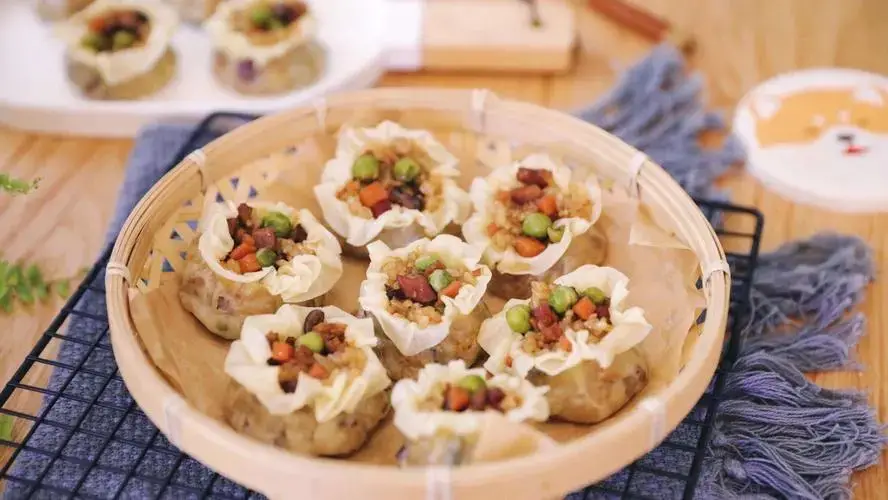
what are shumai made of?
Shumai can be made using rice. When making Shao Mai, sticky rice is typically preferred due to its soft and sticky texture. This ensures that the filling stays intact during the steaming process. Regular rice is less commonly used for Shao Mai as it tends to scatter and is difficult to shape. However, it is still possible to make Shao Mai using regular rice. One example is Crystal Shao Mai, where regular rice is substituted for sticky rice. The other ingredients remain the same as traditional Shao Mai, and purple yam can be added to the dough to prevent it from becoming too firm. Additionally, adding eggs to the rice mixture helps bind the ingredients together, preventing the Shao Mai from falling apart. Therefore, Shao Mai can indeed be made using regular rice.
Basic Ingredients: Sticky rice, dumpling wrappers, green peas, corn kernels, carrots, Chinese sausage, scallions, salt, pepper, soy sauce, oyster sauce, (Southern style) pork, wonton wrappers, (Northern style) beef or lamb, scallions, sticky rice, meat, shiitake mushrooms, dried tofu, braising sauce.
what are shumai wrappers made of?
The main ingredient for the dough of Shao Mai wrappers is flour. In the Guangdong region, a commonly used type of flour is called “Kao Hong” flour, also known as Shao Mai flour. This flour undergoes a special processing method involving multiple steps.
In addition to flour, starch-based ingredients are also added to the shumai wrappers as auxiliary materials. Common starches include corn starch, tapioca starch, and corn flour. The addition of starch helps improve the elasticity and texture of the Shao Mai wrappers, resulting in a better mouthfeel.
what is inside shumai?
Sticky Rice: Shao Mai is a filling staple food known for its savory and fragrant taste, and it wouldn’t be complete without sticky rice. The addition of sticky rice gives Shao Mai a delightful soft and chewy texture.
Shiitake Mushroom: Shao Mai is also typically made with aromatic shiitake mushrooms. Shiitake mushrooms contain abundant aromatic compounds that not only enhance the flavor of Shao Mai but also add to its overall texture.
Carrot: Diced carrots are commonly included in Shao Mai. Carrots have a slightly sweet taste that adds freshness to Shao Mai, and they are also rich in beta-carotene, offering high nutritional value.
types of shumai
Here is the translation of the various types of shumai mentioned:
Henan: Quexian Shumai (Shumai with chopped fillings)
Anhui: Ya You Shumai (Shumai with duck fat)
Jiangsu: Zhi Pi Shumai (Paper-wrapped Shumai)
Jiangxi: Dan Rou Shumai (Shumai with egg and meat)
Hebei: Da Cong Zhu Rou Shumai (Shumai with pork and scallion)
Hohhot: Yang Rou Da Cong Shumai (Shumai with lamb and scallion)
Suzhou: San Xian Shumai (Shumai with three kinds of fillings)
Hangzhou: Niu Rou Shumai (Shumai with beef)
Hunan, Changsha: Ju Hua Shumai (Chrysanthemum-shaped Shumai)
Shandong, Linqing: Yang Rou Shumai (Shumai with lamb)
Guangzhou: Gan Zheng Shumai (Dry-steamed Shumai), Xian Xia Shumai (Shumai with fresh shrimp), Xie Rou Shumai (Shumai with crab meat), Zhu Gan Shumai (Shumai with pork liver), and Pai Gu Shumai (Shumai with pork ribs)
Hohhot Lamb and Green Onion Shao Mai
As the ancestor of shao mai, Hohhot’s shao mai naturally has an excellent taste. Although there are various fillings available, the most famous one is lamb and green onion shao mai, a delicious delicacy that locals cannot resist.
The thin pastry, with its layers resembling a blooming white flower, is visually appealing and can easily distract you from tasting the hearty meat filling.
However, when you take a bite, the rich and savory meat juice fills your mouth, and the sweet and savory flavor of Inner Mongolian lamb, combined with fresh green onions and ginger, instantly captivates all your attention. Even though it might be hot and you need to blow on it, you can’t wait to swallow it.
It’s worth mentioning that in authentic Hohhot shao mai restaurants, shao mai is sold by “liang,” which refers to the weight of the pastry. So, when you order “one liang,” you get eight pieces, which is enough to satisfy your hunger.
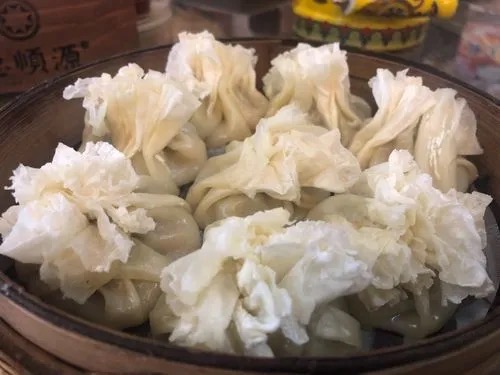
Datong Baihua Shao Mai
Datong’s shao mai is well-known and is the perfect choice for breakfast in Datong. Among them, Baihua Shao Mai, especially the one produced by Fenglinge, is exquisite and tempting.
The shao mai resembles a flower when it comes out of the steamer, with various colors, like blooming white flowers. The appearance is impeccable.
The filling of the shao mai is generous, with each bite bursting with oily fragrance. When you chew it carefully, you can taste the tender and juicy chunks of meat filling. It is truly a skilled contender with both appearance and taste.
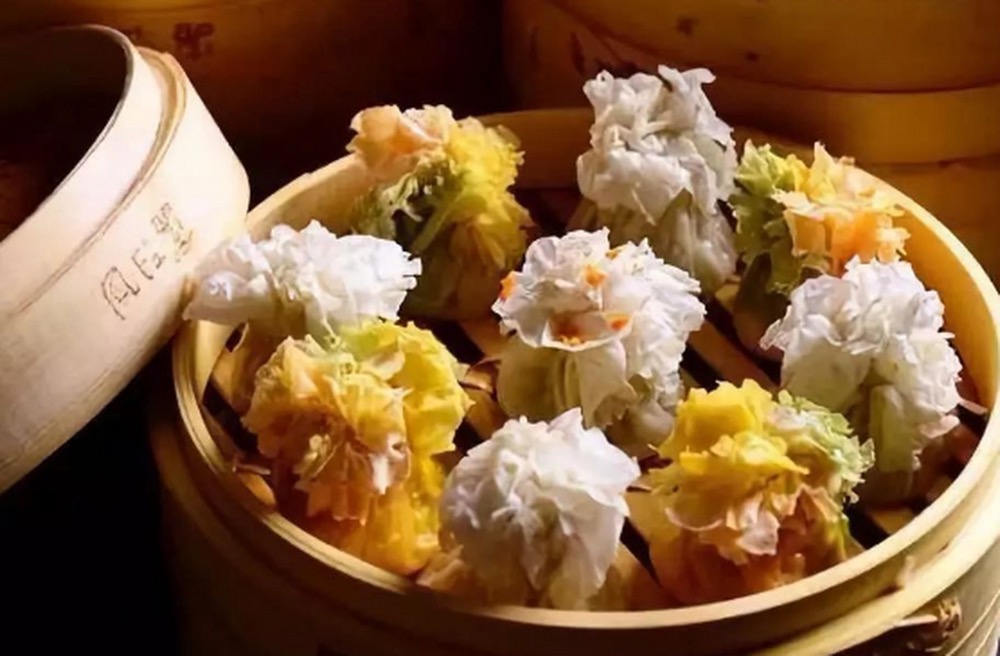
Jiangsu-Zhejiang-Shanghai Glutinous Rice Shao Mai
In the Jiangsu, Zhejiang, and Shanghai regions, shao mai mostly consists of glutinous rice filling instead of meat filling, resulting in a soft and sticky texture.
A bright and enticing glutinous rice shao mai is a perfect fusion of glutinous rice, shiitake mushrooms, and soy sauce. The savory and sticky taste is loved by people in the southern regions, so you can always find it in breakfast cabinets in convenience stores.
On top of that, there is a unique shao mai called Songzi Meirou Shao Mai, which incorporates soy sauce-soaked glutinous rice with pine nuts and diced meat. The unique aroma of the pine nuts makes it a delightful surprise for those who taste it.
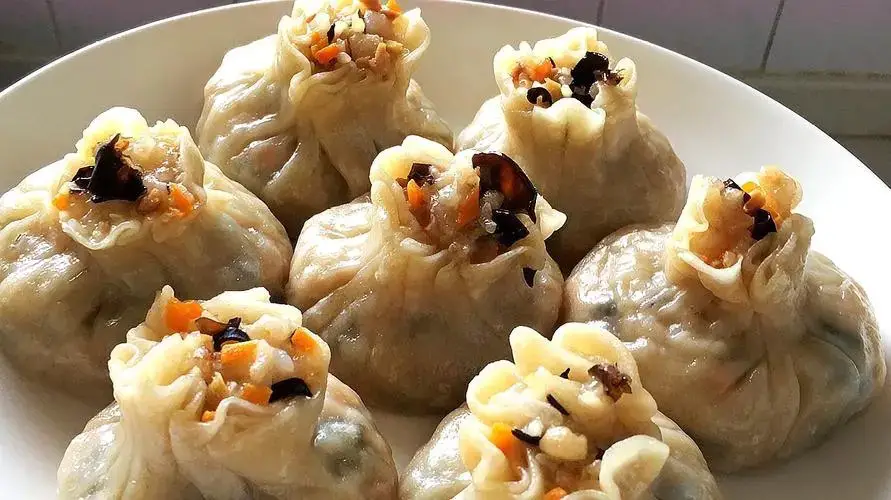
Shanghai Xiasha Shao Mai
In addition to glutinous rice shao mai, Xiasha Shao Mai in Shanghai is also very famous. The shao mai skin is hand-rolled with a special rolling pin, giving it a chewy texture.
There are both sweet and savory fillings. The savory shao mai often includes fresh bamboo shoot dices mixed with meat filling and secret pigskin jelly. During steaming, the pigskin jelly melts into broth, and with each bite, the full-bodied broth, the crispy texture of bamboo shoots, and the elasticity of the skin provide a rich and varied mouthfeel.
The sweet shao mai is filled with bean paste, walnut meat, melon seed meat, and dried tangerine peel. However, most people still prefer the savory bamboo shoot and meat shao mai.
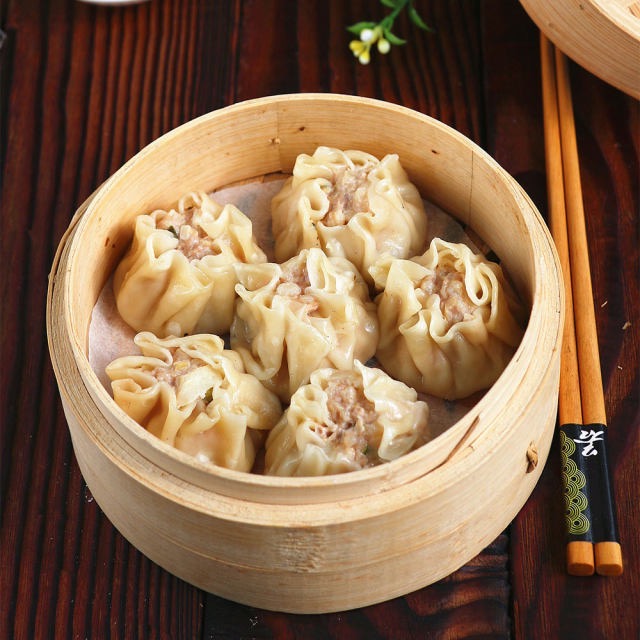
Yangzhou Feicui Shao Mai
Feicui Shao Mai is a classic in Yangzhou’s morning tea culture. Each shao mai resembles an emerald with its vibrant color, making it visually appealing.
During the making process, small greens like spinach or other leafy vegetables are used either as the filling or to make the pastry, resulting in a refreshing and charming green color.
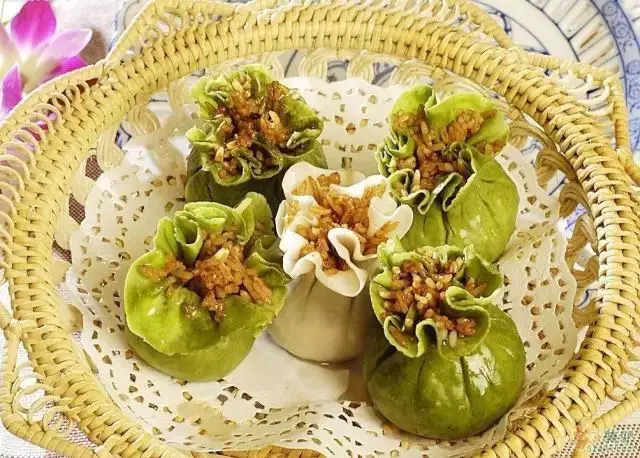
Zhejiang Jiaxing Fresh Bamboo Shoot Shao Mai
Bamboo shoots, a rare delicacy in spring, are used in Jiaxing’s shao mai. Jiaxing locals who love shao mai naturally wouldn’t miss out on it, so the fresh bamboo shoot shao mai was born, bringing forth a refreshing fragrance of spring.
By adding crunchy bamboo shoot dices and rich pigskin jelly to the pork filling, the mouthwatering fresh bamboo shoot shao mai is created. After steaming at high temperatures, the aroma of the bamboo shoots blends harmoniously with the meat filling. With each bite, you can hear the crispy sound of the bamboo shoot dices, offering a truly refreshing experience.
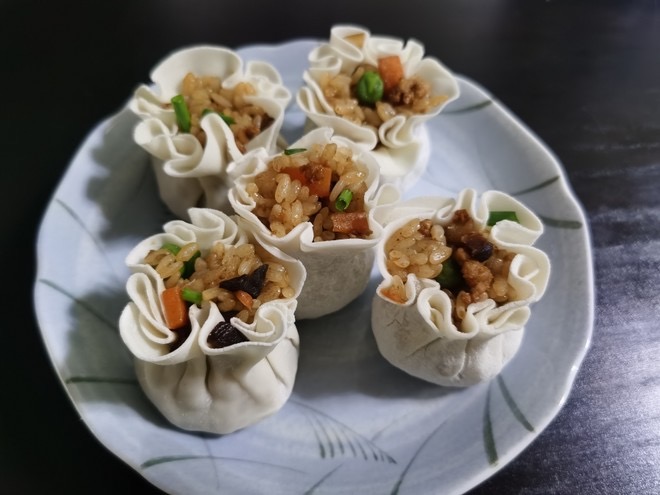
Wuhan Heavy Oil Shao Mai
In Wuhan, shao mai is also known as “shao mei,” and heavy oil shao mei is an essential flavor in Wuhan locals’ breakfast.
What sets it apart from other shao mai is its rich and aromatic pork oil broth and the mildly spicy yet refreshing black pepper. It may initially seem greasy, but your mouth won’t be able to stop indulging in its intense aroma.
Locals in Wuhan enjoy wrapping the shao mai in a deep-fried dough called “you bing” because of its soft and moist exterior, the juicy filling reminiscent of xiaolongbao, and the large pieces of sticky rice attached to the pork. This combination of flavors with the crispy and fragrant you bing is just perfect.
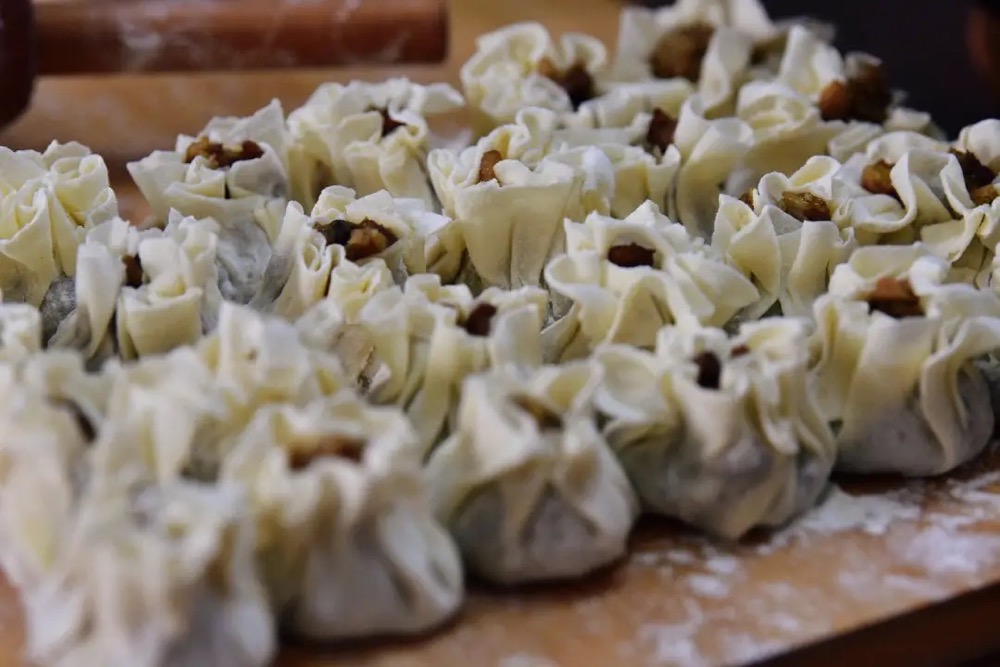
Henan Qie Xian Shao Mai
Qie Xian Shao Mai is a type of shao mai with a rich filling. The colorful toppings make it visually appealing.
Corn, peas, carrots, shrimp, and more are all diced and mixed with glutinous rice to create a flavorful filling, which is then wrapped in the pastry. This results in a shao mai with a rich and savory taste that is not overly greasy.
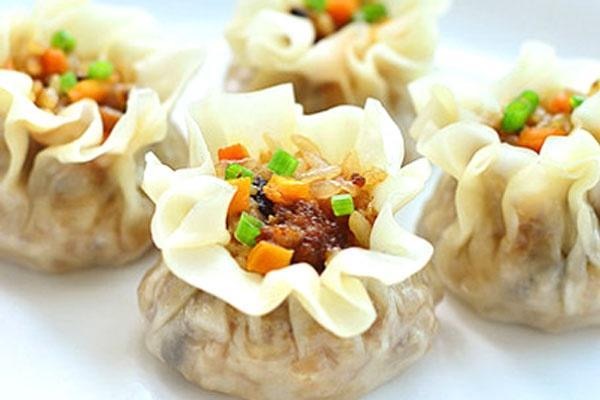
Nanjing Egg Yolk Shao Mai
Nanjing’s shao mai is perhaps the most unique of all because it uses lotus leaves instead of dough to wrap the filling. This gives it a subtle and fragrant aroma.
But the most enticing part is the whole golden egg yolk placed inside the shao mai. It not only adds visual appeal but also offers a delicious taste. After all, the egg yolk alone is a winner!
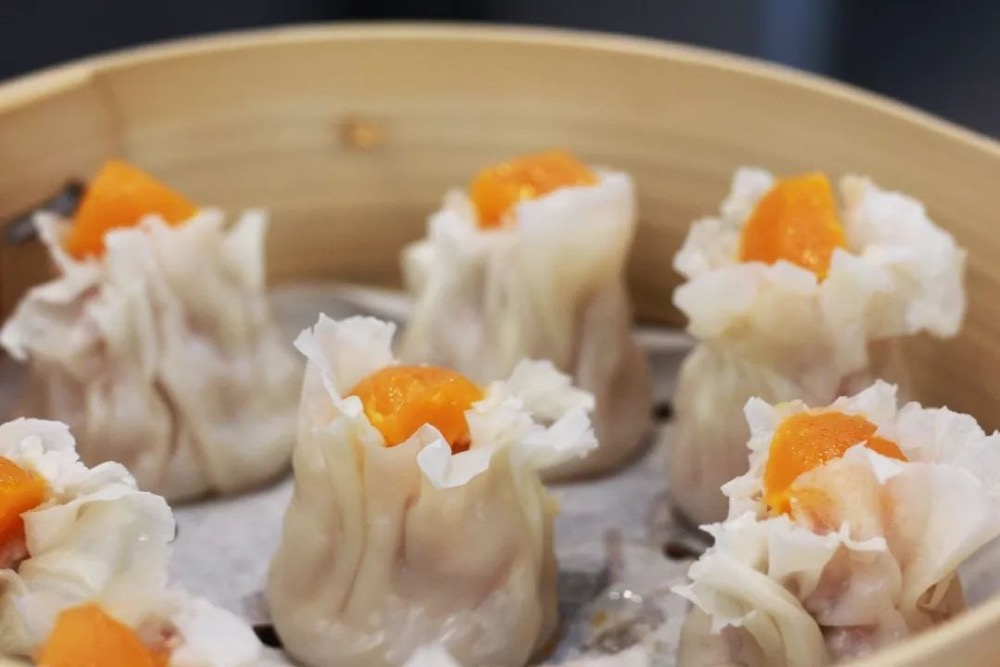
Changsha Chrysanthemum Shao Mai
Chrysanthemum Shao Mai got its name because the opening of this shao mai is filled with an egg yolk, resembling blooming golden chrysanthemums, making it elegant and noble.
But besides its appearance, it also has depth in flavor. The shao mai has a pale and translucent skin, distinct glutinous rice filling, and a slightly salty and fragrant taste with a hint of numbing sensation. It is loved by locals for its perfect balance.
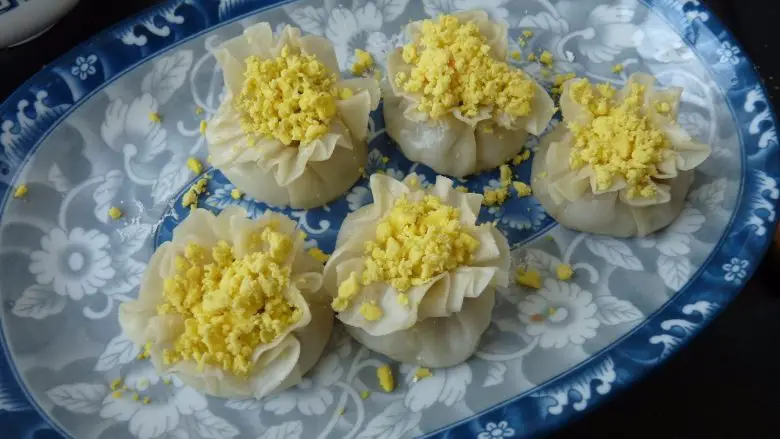
Yunnan Governor Shao Mai
Governor Shao Mai is a Yunnan delicacy from Yiliang. Its preparation differs from other regions. The dough is made with bone broth and oil, and the filling includes a combination of raw and cooked pork mixed with various ingredients, making it truly unique.
The filling is also distinctive, with the addition of Yunnan’s unique ham, in addition to pork, shiitake mushrooms, and bamboo shoot dices. The resulting taste is savory, rich, and full of flavor, leaving you wanting more.
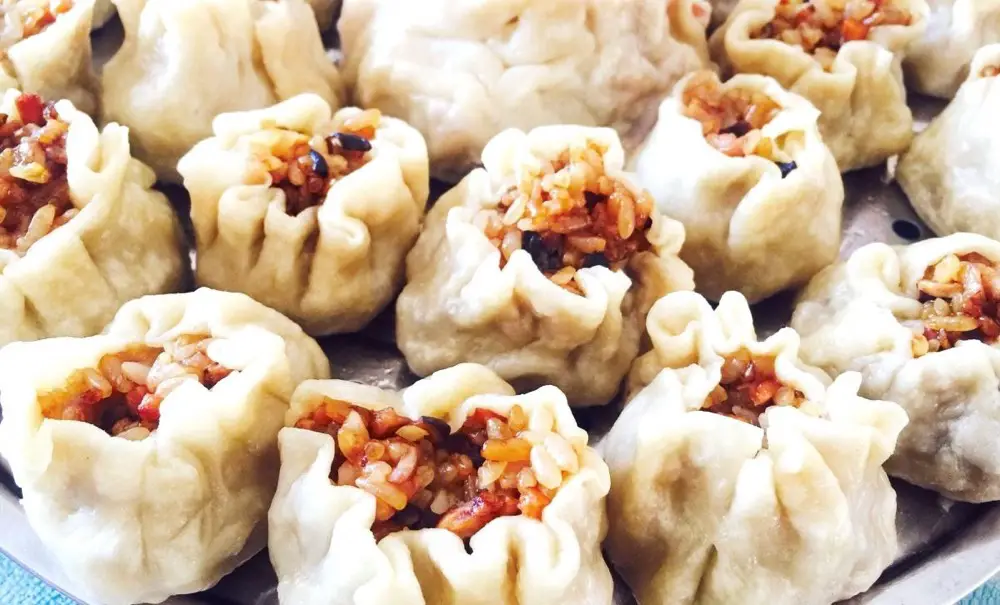
Guangzhou Steamed Shao Mai
In Guangzhou, known for its exquisite dim sum, shao mai is commonly referred to as “gan zheng.” Alongside shrimp dumplings, egg tarts, and barbecue pork buns, it is hailed as one of the four great kings of Cantonese dim sum. Its status speaks for itself.
Gan zheng is small in size, and each piece is wrapped in delicate and slightly yellow dough enriched with egg. The appearance is quite similar for all shao mai, but the fillings vary greatly, including fresh shrimp, crab meat, pork liver, beef, and more. However, the most common and popular flavor is undoubtedly the shrimp roe.
Typically, they come in a set of four, which can be easily consumed by one person. Sometimes, the temptation to order another set arises because the taste is simply too exquisite, capturing your palate with its gentleness.
Apart from these well-known types of shao mai, there are also others with distinct local flavors, such as Hebei’s scallion and pork shao mai, Suzhou’s three delicacies shao mai, Hangzhou’s beef shao mai, Jiangxi’s egg and pork shao mai, Anhui’s duck oil shao mai, and Shandong Linqing’s lamb shao mai, each with its unique characteristics.
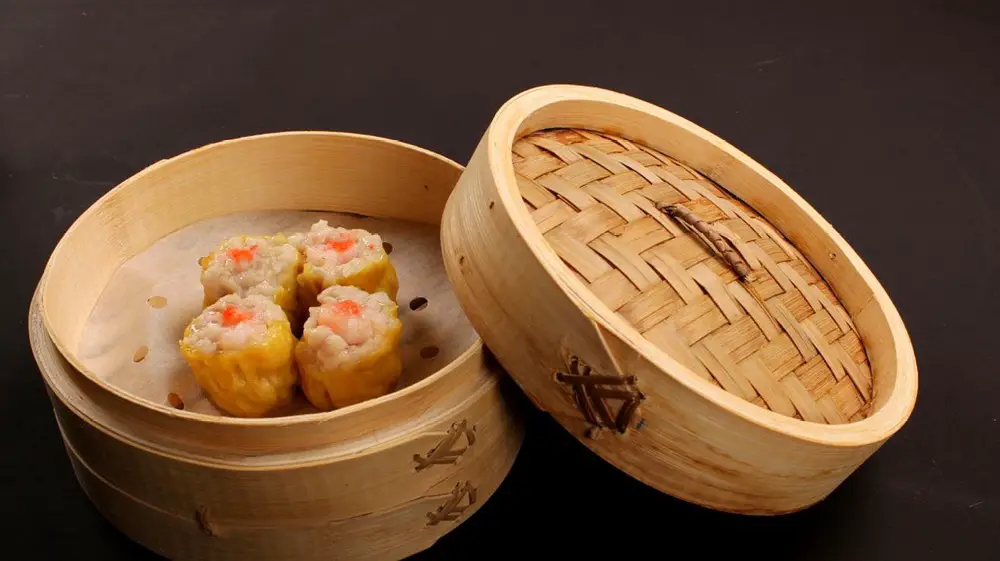
how to make shumai wrappers?
To make shumai wrappers from scratch, you will need the following ingredients:
- 2 cups all-purpose flour
- 1/2 teaspoon salt
- 3/4 cup hot water
- Cornstarch or additional flour for dusting
Here’s a step-by-step guide on how to make shumai wrappers:
- In a large mixing bowl, combine the all-purpose flour and salt. Stir them together.
- Gradually add the hot water to the flour mixture while stirring with a fork or chopsticks. Continue mixing until a rough dough forms.
- Transfer the dough onto a clean surface and knead it for about 5 minutes until it becomes smooth and elastic. If the dough feels too sticky, lightly dust your hands and the surface with additional flour.
- Shape the dough into a ball and cover it with a damp cloth or plastic wrap. Let it rest for about 30 minutes to relax the gluten.
- After the resting time, uncover the dough and divide it into smaller portions. Roll each portion into a long rope about 1/2 inch (1.25 cm) in diameter.
- Cut the rope into small pieces, each weighing around 10 grams. You can adjust the size depending on your desired shumai wrapper size.
- Take one small dough piece and press it flat into a circle using your palm. Alternatively, you can use a rolling pin to roll out each dough piece into a thin circle with a diameter of about 3 inches (7.5 cm). Dust the dough and surface with cornstarch or flour as needed to prevent sticking.
- Repeat the process with the remaining dough pieces until you have made all the shumai wrappers.
Now you have homemade shumai wrappers ready to be filled with your favorite shumai filling. Place a spoonful of filling in the center of each wrapper, gather the edges, and pleat them to create the classic shumai shape. Steam the shumai until cooked, and enjoy!
shumai history
when was shumai invented? Shumai is a highly beloved specialty snack that originated in the early Yuan Dynasty, specifically in the tea houses along the commercial routes in the region of Hohhot, Inner Mongolia. During the Ming and Qing Dynasties, while the term “shao mai” (稍麦) was still in use, the names “shao mai” (烧卖) and “shao mai” (烧麦) also emerged and became more commonly used.
In the novel “Rulin Waishi” (The Scholars) in the tenth chapter, it mentions: “There were two plates of dim sum on the table, one plate of pork-filled shao mai and one plate of steamed dumplings with goose fat and white sugar.” The “Peach Blossom Shao Mai” is also mentioned in the “Jin Ping Mei Cihua” (The Plum in the Golden Vase). During the reign of Emperor Qianlong in the Qing Dynasty, there is a line in a popular song that says: “The table is filled with shao mai and wontons.”
The term “shao mai” appears in works such as Li Dou’s “Yangzhou Huafanglu” and Gu Lu’s “Tongqiao Yizhao Lu.” In the story “Kuaizi Li Cuilian Ji” in “Qingping Shantang Hua Ben” (Tales of the Clear and Peaceful Studio), it says: “Shao mai and other snacks, what’s difficult about them? Three servings of soup, two servings of meat, I can do that too.” Fu Chongju’s “Chengdu Tonglan: Chengdu’s Food and Recipes” lists various types of shao mai, including “pork-filled shao mai, vegetable-filled shao mai, frozen vegetable-filled shao mai, lamb-filled shao mai, chicken skin-filled shao mai, wild chicken-filled shao mai, golden hook-filled shao mai, vegetarian-filled shao mai, sesame-filled shao mai, plum blossom-filled shao mai, lotus seed-filled shao mai…” In the anonymous Qing Dynasty cookbook “Diaoding Ji,” there are recipes for “meat-filled shao mai,” “red bean paste-filled shao mai,” “oil and sugar-filled shao mai,” and more.
Among them, “meat-filled shao mai” is made with chicken meat and ham mixed with seasonal vegetables as the filling. “Oil and sugar-filled shao mai” is made with diced suet, walnut kernels, and white sugar as the filling. There is also a southern Chinese variety called “braised meat and pickled vegetable shao mai.”
origin and legends
The origin and legends surrounding the name of shumai have multiple accounts. One says that during the late Ming and early Qing Dynasty, in the vicinity of Da South Street and Dazhao Temple in Huhehaote (now Hohhot), Inner Mongolia, there were two brothers who made a living by selling buns. Later, the older brother got married, and his wife demanded that they separate their businesses. The bun shop went to the brother and sister-in-law, while the younger brother continued working at the shop making and selling buns. However, the kind-hearted younger brother barely had any money left after eating, so in order to increase his income and save money to get married in the future, he started making “buns” with thin open skins on top, differentiating them from the regular buns. The money from selling regular buns went to the older brother, while the earnings from the “slightly different” buns were accumulated. Many people liked these buns that didn’t look like regular buns, and they were named “shao mai.” As the name spread southward, it eventually became known as “shumai.”
Another account states that in the third year of the Qianlong Emperor’s reign, a person surnamed Wang from Beijing’s Beijinglei Village in Fushan County opened a Fushan Shumai Restaurant near Xianyukou outside Qianmen in Beijing. They specialized in making fried triangles and various famous dishes. On one New Year’s Eve, Emperor Qianlong returned from a private visit to Tongzhou and went to Fushan Shumai Restaurant to eat shumai. The shumai at this place had a soft, fragrant filling that was oily but not greasy, and it was pure white and translucent, resembling pomegranate seeds. Emperor Qianlong was highly impressed and couldn’t stop praising it. After returning to the palace, he personally wrote the three characters “Du Yi Chu” (meaning “all in one place”) and had them made into a plaque, which was sent to Fushan Shumai Restaurant. From then on, the restaurant’s reputation skyrocketed, and its value doubled. However, this story has little connection to the origin of the name.
The reason why shumai has an open top is related to the variety of side dishes that tea customers brought along. Some had raw beef or mutton with ginger and green onions, while others had radishes, greens, or dried tofu. In order to distinguish the different side dishes for each customer, the tops were left open. After steaming a basket of shumai, the waitstaff would bring the steamer to the large table in the tea room and say, “Here are the side dishes for all the tea customers, please help yourselves.” At that point, the customers would each select their own “thin pancake with vegetable filling” and enjoy it with tea.
Another theory is that shumai originated from buns. The main differences between shumai and buns, apart from using unleavened dough for the wrappers, include the open top and the shape resembling a pomegranate.
Today, shumai varieties are even more diverse across different regions and made with more exquisite craftsmanship. Examples include Hohhot’s lamb and green onion shumai, Henan’s diced filling shumai, Hebei’s pork and green onion shumai, Anhui’s duck fat shumai, Hangzhou’s beef shumai, Jiangxi’s egg and meat shumai, Linqing’s lamb shumai in Shandong, Suzhou’s three delicacies shumai, Changsha’s chrysanthemum-shaped shumai, Guangzhou’s steamed dry shumai, fresh shrimp shumai, crab meat shumai, pork liver shumai, beef shumai, and spare rib shumai, among others, each with its own local characteristics.
Translation into English: The name “shumai” has multiple origins and legends associated with it. One account tells the story of two brothers running a bun shop in Huhehaote, Inner Mongolia. When the elder brother got married, the younger brother created a slightly different bun called “shao mai” to distinguish it from regular buns and increase their income. Over time, the name evolved and spread to southern regions, becoming “shumai.”
Another legend describes Emperor Qianlong’s visit to a shumai restaurant in Fushan County. Impressed by the delicious shumai, the emperor gifted a plaque with the inscription “Du Yi Chu” to the restaurant, boosting its reputation.
The open top of shumai is attributed to the various side dishes that customers brought along. To differentiate the fillings, the tops were left open. Customers would select their preferred shumai while enjoying tea.
Today, shumai has evolved into a wide variety of flavors and styles across different regions, such as lamb and green onion shumai in Hohhot, diced filling shumai in Henan, pork and green onion shumai in Hebei, duck fat shumai in Anhui, beef shumai in Hangzhou, egg and meat shumai in Jiangxi, lamb shumai in Linqing, three delicacies shumai in Suzhou, chrysanthemum-shaped shumai in Changsha, and a range of shumai variations in Guangzhou, including steamed dry shumai, fresh shrimp shumai, crab meat shumai, pork liver shumai, beef shumai, and spare rib shumai, each reflecting local characteristics.
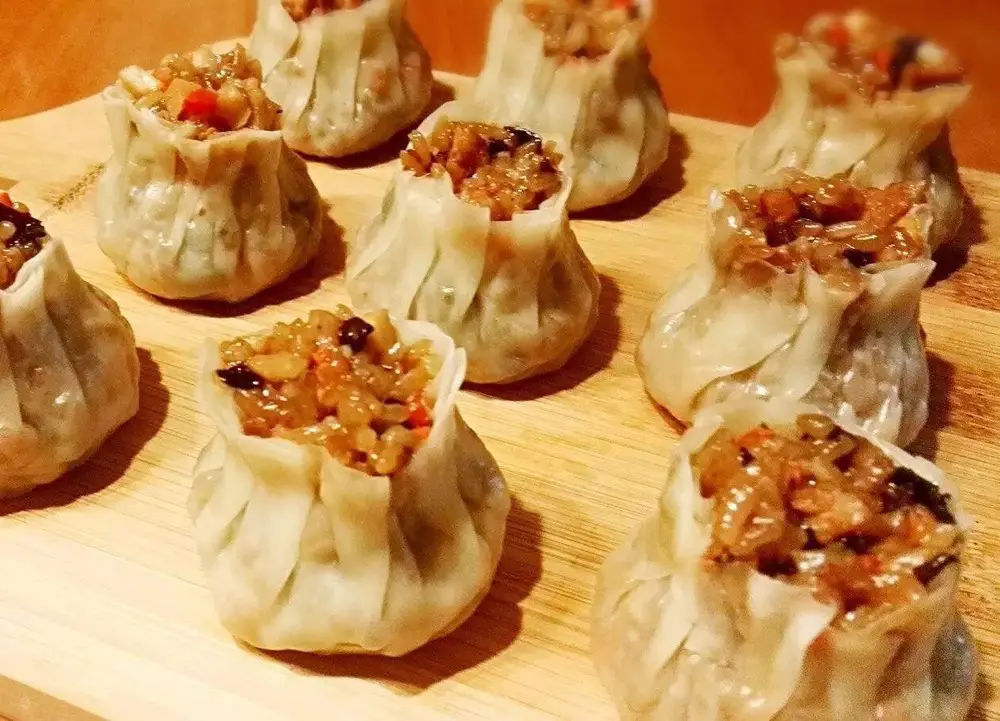
what does shumai mean?
The origin of the word “shumai” has various explanations. One explanation states that in the early years, shumai in Hohhot were primarily sold in tea houses. Customers would enjoy strong brick tea or various types of herbal tea while eating pastries. They would also eat the hot and steaming shumai alongside their tea. Therefore, shumai came to be known as “shaomai,” which can be interpreted as “selling together with tea” or “selling while having tea.” Another interpretation suggests that the slightly wrinkled edges of shumai resemble flowers, leading to the name “shaomei,” meaning “beautiful edges” or “beautifully cooked edges.” Over time, shumai has become a delicious staple food, and people commonly refer to it as “shumai” in general.
For the traditional Chinese New Year’s Eve dinner, it is customary to have a “Wealth and Prosperity” lucky bag, symbolizing good fortune for the new year. Shumai, with its shape resembling a lucky bag, is filled with ingredients representing blessings and wealth, symbolizing an abundance of fortune. It is hoped that the “Chinese New Year lucky bag” will bring blessings to everyone.
shumai in Chinese medicine
Shumai is a traditional food with a long history, and it is highly nutritious and an excellent tonic. Shumai offers numerous health benefits, including moistening the lungs and relieving cough, nourishing yin and moisturizing dryness, clearing heat and detoxifying, anti-cancer and disease-fighting properties, strengthening the spleen and nourishing the stomach, replenishing deficiencies and stopping bleeding, nourishing the kidneys and boosting vitality, and anti-aging effects.
how is shumai made?
Shumai, also known as siu mai or shaomai, is a type of Chinese dumpling traditionally made with a filling of ground meat (commonly pork) and various seasonings. Here’s a general recipe for making shumai:
Ingredients:
- Shumai wrappers (round or square)
- Ground meat (pork, chicken, or a combination)
- Shrimp (optional)
- Finely chopped vegetables (such as mushrooms, water chestnuts, or bamboo shoots)
- Soy sauce
- Oyster sauce
- Sesame oil
- Salt and pepper
- Cornstarch (for binding)
Instructions:
Prepare the filling: In a mixing bowl, combine the ground meat, finely chopped vegetables, and optional shrimp. Add soy sauce, oyster sauce, sesame oil, salt, pepper, and cornstarch. Mix well until all ingredients are evenly incorporated.
Assemble the shumai: Take a shumai wrapper and place it in the palm of your hand. Spoon a small amount of the filling onto the center of the wrapper, about 1 to 1.5 tablespoons. Gather the edges of the wrapper and gently pleat them around the filling, leaving the top open. Press lightly to secure the pleats and shape the shumai. Repeat this process for the remaining wrappers and filling.
Steam the shumai: Line a steamer basket with parchment paper or cabbage leaves to prevent sticking. Arrange the shumai in the steamer, leaving some space between them to prevent sticking. Steam over high heat for about 8-10 minutes, or until the filling is cooked through and the wrappers become translucent.
Serve: Carefully remove the steamed shumai from the steamer and transfer them to a serving plate. They can be enjoyed as they are or served with dipping sauces such as soy sauce, chili sauce, or a combination of soy sauce and vinegar.
Note: This is a basic recipe, and you can customize the filling according to your preference by adding other ingredients like minced ginger, garlic, or additional seasonings. Additionally, the cooking time may vary, so it’s recommended to check the doneness of the filling by cutting into one shumai before serving.
are shumai dumplings
Yes, shumai is a type of dumpling. Shumai is a popular Chinese dumpling that is typically open-faced with a pleated wrapper. It is known for its distinctive shape and is often filled with a mixture of ground meat (such as pork or chicken), shrimp, and vegetables. Shumai is usually steamed and can be enjoyed as a dim sum dish or as a snack. It is commonly served with soy sauce or other dipping sauces.
are shumai healthy
Shumai can be a relatively healthy food option, depending on the ingredients used and the cooking method. Here are some factors to consider:
Filling: The filling of shumai typically includes a combination of meat (such as pork or chicken), shrimp, and vegetables. These ingredients can provide protein, vitamins, and minerals. However, the specific nutritional profile will depend on the ingredients and proportions used.
Steaming: Shumai is commonly steamed, which is a healthier cooking method compared to deep-frying. Steaming helps retain nutrients and reduces the amount of added fats and calories.
Portion Size: It’s important to consider portion size when consuming shumai. Since shumai is often served as part of a dim sum platter or as a snack, it’s easy to consume multiple pieces. Moderation is key to maintain a balanced diet.
Sodium Content: Some shumai recipes or dipping sauces may contain added sodium, especially if soy sauce is used. Excessive sodium intake can be a concern for individuals with certain health conditions, such as high blood pressure. Opting for low-sodium soy sauce or reducing the amount used can help manage sodium intake.
Overall, shumai can be a nutritious food choice when made with lean protein, plenty of vegetables, and steamed rather than fried. It’s always a good idea to consider the ingredients and cooking methods when assessing the overall healthiness of any food.
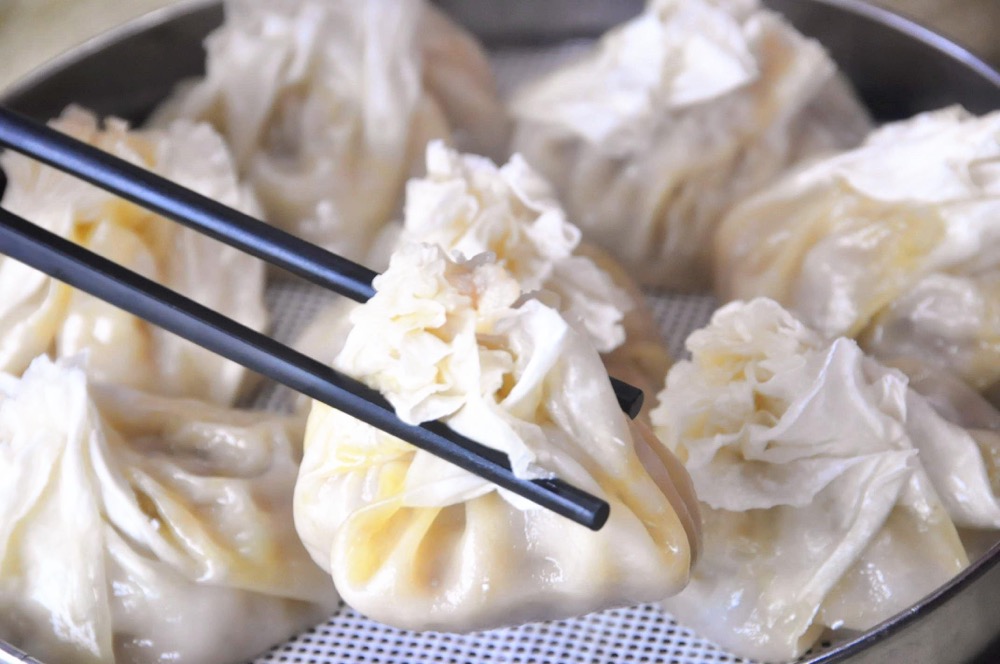
are shumai gluten free
Traditional shumai wrappers are typically made from wheat flour, which contains gluten. Therefore, standard shumai is not considered gluten-free. However, there are gluten-free alternatives available that can be used to make shumai wrappers. These alternatives may include rice flour, tapioca starch, or other gluten-free flours. If you have a gluten intolerance or sensitivity, it’s important to check the specific ingredients and preparation methods used when purchasing or consuming shumai to ensure it is gluten-free.
are shumai fattening
Shumai can vary in terms of their nutritional content depending on the specific ingredients and cooking methods used. Generally speaking, shumai is a relatively moderate-calorie food due to its small size. However, the filling and wrapper can contribute to the overall calorie and fat content.
Shumai fillings often contain a combination of ground meat (such as pork or shrimp), vegetables, and seasonings. The calorie and fat content can vary depending on the type and ratio of ingredients used. Steamed or boiled shumai tend to be lower in fat compared to fried versions.
It’s important to note that shumai is typically enjoyed as part of a larger meal or dim sum spread, and portion control is key to maintaining a balanced diet. Eating excessive amounts of shumai, especially those that are fried or made with fatty meats, can contribute to weight gain over time. As with any food, it’s advisable to consume shumai in moderation as part of a well-rounded and varied diet.
shumai vs wonton
Shumai and wonton are both popular types of Chinese dumplings, but they have some differences in terms of their appearance, filling, and cooking methods.
Appearance: Shumai, also known as siu mai, typically has an open top and a pleated wrapper that exposes the filling. It is usually shaped like a small cup or basket. Wonton, on the other hand, has a closed and sealed wrapper that encloses the filling. It is usually formed into a triangular or square shape.
Filling: Shumai traditionally has a filling made with a combination of ground pork, shrimp, or other meats, along with vegetables and seasonings. It has a more substantial and chunky filling. Wonton fillings are often made with ground pork or shrimp mixed with seasonings, but they can also include other ingredients like minced chicken or vegetables. The filling is usually more finely minced or pureed compared to shumai.
Cooking methods: Shumai is commonly steamed, although it can also be pan-fried. Steaming is the preferred method as it preserves the delicate texture of the wrapper and filling. Wontons are often boiled and served in soups, such as wonton soup. They can also be deep-fried or steamed, depending on the desired preparation.
Regional variations: Shumai is more commonly associated with Cantonese cuisine and is a popular dim sum item. Wontons, on the other hand, are popular across various regional Chinese cuisines and can be found in different styles, such as Sichuan-style wontons or Shanghai-style soup dumplings (xiaolongbao).
In terms of taste and texture, shumai and wonton can vary based on the specific recipe and ingredients used. They are both delicious and versatile dumplings that offer a different culinary experience.
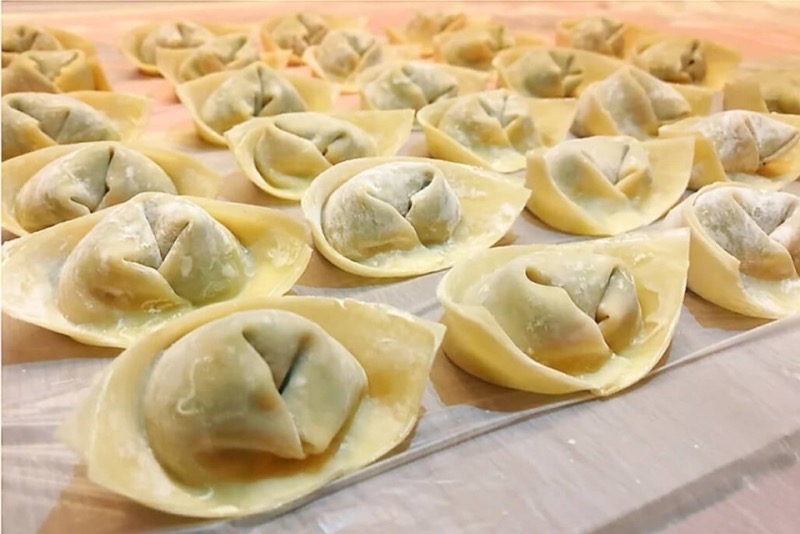
shumai vs bao
Shumai and bao (also known as baozi or steamed buns) are both types of Chinese dumplings, but they differ in several aspects, including their appearance, filling, and cooking methods.
Appearance: Shumai typically has an open top with a pleated wrapper, resembling a small cup or basket. The filling is partially exposed. Bao, on the other hand, is a fully enclosed dumpling with a soft and fluffy steamed bun exterior. It is usually larger in size and has a round or folded shape.
Filling: Shumai fillings commonly consist of a mixture of ground meat (such as pork, chicken, or shrimp), along with vegetables, seasonings, and sometimes mushrooms or other ingredients. The filling has a chunkier texture. Bao fillings can be diverse and include various ingredients such as meat (pork, beef, or chicken), vegetables, and even sweet fillings like custard or red bean paste. Bao fillings are usually more substantial and often have a softer texture.
Cooking methods: Shumai is typically steamed, although it can also be pan-fried. Steaming is the preferred cooking method to retain the delicate texture of the wrapper and filling. Bao, as the name suggests, is steamed. The dough for bao is made with yeast, which gives it a fluffy and slightly sweet taste. Bao can also be baked or pan-fried in some regional variations.
Serving style: Shumai is commonly served as part of dim sum or as an appetizer. It is often eaten with a dipping sauce, such as soy sauce or chili oil. Bao, on the other hand, can be a standalone dish or a more substantial meal. It is often enjoyed as a street food snack or as part of a meal.
Both shumai and bao are delicious and popular in Chinese cuisine, but they offer different experiences. Shumai is smaller, open-faced, and has a chunkier filling, while bao is larger, fully enclosed, and has a fluffy steamed bun exterior with a more varied range of fillings.

shumai vs zongzi
Shumai and zongzi are both traditional Chinese foods, but they are quite different from each other in terms of ingredients, preparation, and appearance.
Ingredients: Shumai is typically made with a thin wheat or rice wrapper and filled with a mixture of ground meat (such as pork, chicken, or shrimp), vegetables, and seasonings. It is often seasoned with soy sauce, sesame oil, and other flavorings. Zongzi, on the other hand, is made with glutinous rice and wrapped in bamboo leaves. The fillings of zongzi vary but commonly include sticky rice, meats (such as pork belly or chicken), salted egg yolks, beans, nuts, and mushrooms.
Preparation: Shumai is prepared by placing the filling in the center of the wrapper, then pleating and folding the edges to create a small open-faced dumpling. It is steamed to cook the filling and soften the wrapper. Zongzi involves a more intricate preparation process. Glutinous rice is soaked, and then the bamboo leaves are folded to form a cone or rectangle shape. The rice and various fillings are added to the cone, and the leaves are tightly wrapped and secured with string or bamboo strips. Zongzi is then boiled or steamed for several hours until the rice becomes tender and infused with the flavors from the fillings and leaves.
Appearance: Shumai has a small, open-faced shape with the filling partially exposed. It is usually bite-sized and can be pleated or formed into various shapes. Zongzi, on the other hand, is larger and wrapped in bamboo leaves, creating a pyramid or rectangular shape. The leaves give zongzi a distinctive aroma and impart flavor to the rice during the cooking process.
Occasions and serving: Shumai is commonly served as part of dim sum, as an appetizer, or as a snack. It is often enjoyed with dipping sauces such as soy sauce or chili oil. Zongzi is traditionally associated with the Dragon Boat Festival in China and is a popular food during that time. It is also enjoyed throughout the year as a special treat. Zongzi is unwrapped before eating, revealing the sticky rice and fillings, and it is often enjoyed as a meal or a substantial snack.
In summary, shumai and zongzi differ in terms of ingredients, preparation methods, appearance, and occasions for consumption. Shumai is a small, open-faced dumpling with a wheat or rice wrapper, while zongzi is a larger, pyramid-shaped rice dumpling wrapped in bamboo leaves.
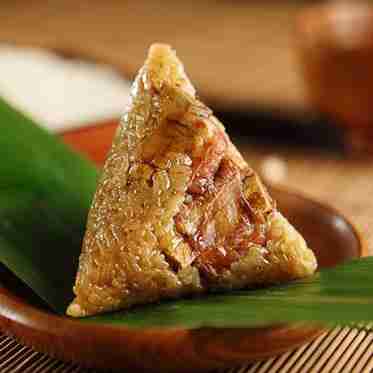
shumai vs Cheung Fun
Shumai and Cheung Fun (also known as Rice Noodle Rolls) are both popular dishes in Cantonese cuisine, but they are distinct from each other in terms of ingredients, preparation, and appearance.
Ingredients: Shumai is typically made with a thin wheat or rice wrapper and filled with a mixture of ground meat (such as pork, chicken, or shrimp), vegetables, and seasonings. It is often seasoned with soy sauce, sesame oil, and other flavorings. Cheung Fun, on the other hand, is made from a delicate rice noodle sheet. The fillings in Cheung Fun can vary and may include ingredients like shrimp, char siu (barbecue pork), beef, or vegetables. It is often served with a sweet soy sauce or hoisin sauce.
Preparation: Shumai is prepared by placing the filling in the center of the wrapper and pleating or folding the edges to create a small open-faced dumpling. It is then steamed to cook the filling and soften the wrapper. Cheung Fun involves a different preparation process. A thin layer of rice noodle batter is poured onto a flat steaming tray, spread evenly, and then steamed until it sets into a translucent sheet. The sheet is then filled with ingredients, rolled up tightly, and cut into bite-sized pieces before being served.
Appearance: Shumai has a small, open-faced shape with the filling partially exposed. It is typically served as individual dumplings. Cheung Fun, on the other hand, consists of long, cylindrical rolls made from the thin rice noodle sheet. The rolls are usually cut into bite-sized pieces and served on a plate. The rice noodle rolls have a smooth and slightly chewy texture.
Serving Style: Shumai is commonly served as part of dim sum or as a standalone dish. It is often enjoyed with dipping sauces such as soy sauce, chili oil, or a combination of both. Cheung Fun is often served as a breakfast or brunch item in Cantonese cuisine. It can be enjoyed plain or filled with various ingredients, and it is typically served with a flavorful sauce poured over the rolls.
In summary, while both shumai and Cheung Fun are delicious Cantonese dishes, they differ in terms of ingredients, preparation methods, appearance, and serving styles. Shumai is a small, open-faced dumpling with a wheat or rice wrapper and various fillings, while Cheung Fun consists of rice noodle rolls filled with ingredients and served with sauce.
Conclusion
Shumai is a beloved dumpling in Chinese cuisine, celebrated for its delicate appearance, savory fillings, and cultural significance. Originating from Guangdong province, these delectable morsels have become synonymous with dim sum feasts and are savored by people around the world. Whether you enjoy them at a traditional dim sum restaurant or attempt to make them at home, the artistry and flavors of shumai are sure to leave a lasting impression. So, next time you encounter these delightful dumplings, take a moment to appreciate the craftsmanship and culinary heritage they represent as you savor each delectable bite.